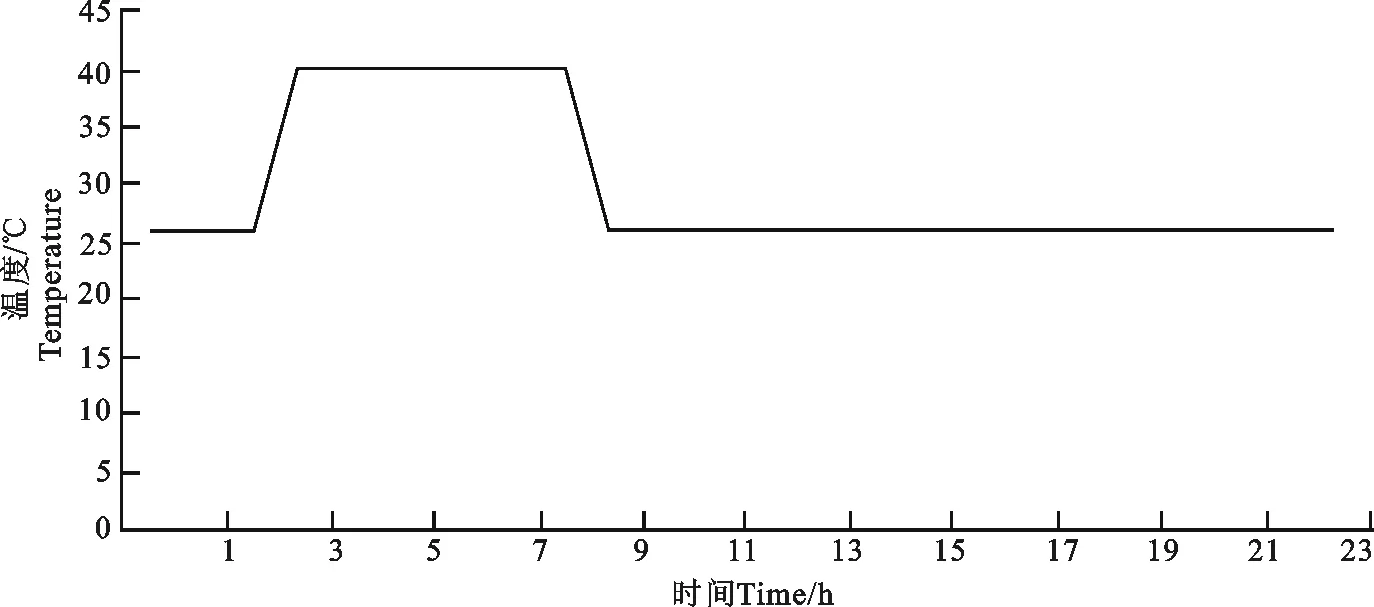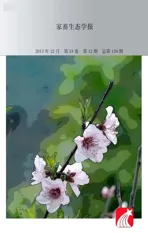中草药复合制剂对热应激仔猪血液流变学指标的影响
2013-11-30彭晓清刘凤华颜培实
彭晓清,刘凤华,颜培实
(1.南通大学 实验动物中心,江苏 南通 226001;2.北京农学院 动物科学系,北京 100026;3.南京农业大学 动物科技学院,江苏 南京 210009)
健康维系着畜产品的安全与高产,以康乐求高产为环境调协循环型畜牧业的永久主题。不仅仅停留在以前的安全和口感,环境和福利问题是人们最关注的[1]。在畜牧生产中,热应激对畜禽的危害很大。猪虽然有汗腺,但被毛稀少在炎热环境中并不发汗[2],容易受到热应激的影响。
根据传统中医理论,热应激是暑热之邪致病,属于温病学范畴。温为热之渐,火为热之极。热为病之源,应激为热之证。因此,治疗要清热凉血,促进机体热量散失以缓解热应激症状。近年来,使用促进散热的天然素材—中草药作为饲料添加剂,在预防和治疗热应激方面取得了较理想的效果,受到了人们的普遍关注。本实验室采用中草药复合制剂,用于防治热应激取得了理想的效果[4-5],但对其抗热应激作用机制未做进一步研究。血液是机体运输营养物质、代谢废物和气体的中间介质,血液流变学指标的检测对于各类疾病的诊断和治疗具有重要的临床指导意义[3],血液流变异常可以反映导致疾病的生理应激,但是猪在长期热应激下血液流变学特性尚不清晰。
本研究通过检测热应激对仔猪血液流变学的影响,观察其变化规律,并利用中草药提取物复合制剂对热应激仔猪进行治疗,剖析中草药对热应激下仔猪的散热调节机制,旨在为探讨中药复方防治热应激的机制和组方的改进提供依据。
1 材料与方法
1.1 试验动物及试验设计
试验选择64头中国试验用小型猪(2月龄、体重7.15±0.59 kg), 按窝别、体重相似原则分为常温对照组、高温应激组、高温中草药复合提取物Ⅰ组、高温中草药复合提取物Ⅱ组,每组4个重复,每个重复4头猪。预试期5 d,预试期间环境、饲养水平完全相同;正试期10 d,各组均饲养于人工气候室中(高温组温度:26~40 ℃,24 h循环变温,40 ℃高温维持5 h;常温对照组:温度设定为23 ℃)。高温应激组人工气候仓温度曲线见图1。
1.2 试验动物饲养管理
试验基础日粮按照NRC(1998)营养需要设计,仔猪自由采食和饮水。对照组和高温应激组饲喂基础日粮治疗组饲喂处理日粮,即在基础日粮中按0.5%比例添加提取物复合制剂(提取物复合制剂Ⅰ:由藿香、苍术、黄柏、石膏按等比例混合提取制备;提取物复合制剂Ⅱ:由藿香、苍术、黄柏、石膏按1∶1∶1∶0.5比例混合提取制备)。设置各组环境湿度等完全一致(湿度 H∶60 %;光照度 L∶100 L X)。

图1 人工气候仓温度曲线Fig.1 Temperature curve of artificial weathering cabin
1.3 测定指标与方法
于试验的第1、3、6、10天,每组中选4头猪,每头空腹采集血样10 mL,立即放入加入肝素钠(0.2 mg / mL)的塑料试管中,1 mL通过Wintrobe测试分析红细胞压积,其余的用血液流变自动分析系统分析全血黏度等血液流变学参数(200、1的剪切率下)[6]。
1.4 数据处理
试验数据用SPSS 13.0进行统计分析,结果用“平均值±标准差”表示。
2 结果与分析
2.1 全血黏度的变化
由表1可知,与常温组比较,应激组全血黏度高切变率在试验的第1和3天低于常温组,后升高,第10天显著高于常温组(P<0.05)。中草药提取复合物Ⅰ组第10天显著低于高温组(P<0.05)。中草药提取复合物Ⅱ组3和6 d均低于高温组,到第10天与应激组比较有显著差异(P<0.05)。

表1 猪全血黏度高切变率(200s-1)变化Table 1 The changes of whole blood viscocity of pig under high shear rate
注:同列肩标相同字母表示差异不显著(P>0.05);不同字母表示差异显著(P<0.05)。下同。
Note:Values sharing a superscript are not different (P>0.05),values sharing different superscripts are significantly different(P<0.05). The same below.
由表2可知,与常温组比较,应激组全血黏度低切变率在试验的第1、3天低于常温组,之后逐渐升高,但与常温组比较无显著差异(P>0.05)。中草药提取复合物Ⅰ组与应激组各天之间均无显著差异(P>0.05)。中草药提取复合物Ⅱ组3和6 d均低于应激组,到第10天显著低于应激组(P<0.05)。
2.2 中草药复合制剂对红细胞变形指数的影响
由表3可知,应激组红细胞变形指数在试验的第6和10天显著低于常温组(P<0.05);中草药提取复合物Ⅰ组、Ⅱ组在第6天和第10天显著高于应激组(P<0.05),且高于对照组,但差异不显著(P>0.05)。
2.3 中草药提取复合制剂对红细胞压积的影响
由表4可知,应激组红细胞压积在试验的第6和10天显著高于常温组(P<0.05);中草药提取复合物Ⅰ组在试验的第10天显著低于应激组(P<0.05),中草药提取复合物Ⅱ组在第6天和第10天均显著低于应激组(P<0.05)。

表2 猪全血黏度低切变率(1s-1)变化Table 2 The changes of whole blood viscocity of pig under low shear rate

表3 红细胞变形指数的变化Table 3 The changes of erythrocyte deformation index

表4 红细胞压积的变化Table 4 The changes of hematocrit
3 讨 论
3.1 猪血液流变学指标在长期高温应激条件下的变化规律
血液流变学研究血压、血流量和血管阻力包括全血黏度、红细胞变形性、红细胞聚集性和血小板聚集性,他们可以反映全身的血液循环和疾病的发展过程。因此,血液流变学通常被用来诊断、预防疾病和评价药效。本试验中,应激组全血黏度和红细胞压积在受热的1~3 d有所下降,有研究表明,急性的暴露于高温环境中也会使WBV和HCT诱导性的下降[7-8],这与本研究在热应激初期观察到的结果一致。在高温的作用下,猪在热应激初期的血流加速,红细胞在血管内流动加快,红细胞之间聚集很难,所以全血黏度在低切变下降低。很多研究已表明热暴露会使水摄取量上升[9],增多的水摄取量可能进入脉管系统,循环液体增多血液被稀释,血浆和全血容量增加使得全血黏度下降。研究表明,在高温应激下牛的血浆和全血容量会上升[10-11];将鸡暴露于30 ℃的环境下血浆和全血容量明显上升[12]。因此,我们分析认为高温条件下全血黏度的下降也许是循环液体的增多引起的。高温条件下,全血黏度的下降有利于增加组织灌注量、加快血液循环、增加体表微循环灌注量,减轻心脏负担以及降低外周循环阻力等,这些应答能提高暴露在高温环境下猪机体的散热能力。
红细胞压积与全血黏度的改变是关联的[13]。红细胞压积的增高一直被认为是机体为了提高血液中的氧含量和增强红细胞氧气运输能力的一种代偿调节和适应。在鸟类上发现,HCT在高温下会保持缓慢下降[14-15]。有研究证明,影响血液黏度的首要因素是红细胞压积的变化,血液黏度会随红细胞压积升高按对数关系增高[16]。红细胞变形性与外周微血管循环或者血液运输氧能力紧密相关,主要影响高剪切力下的全血黏度。红细胞变形性的改变在人体血液黏度和血浆黏度的变化中起着重要作用。本研究中,随着高温应激时间的延长,全血黏度高切变值和红细胞压积有逐渐升高的趋势,且在第10天显著增高(P<0.05),与此同时红细胞变形指数在热应激的第6、10天显著低于对照组(P<0.05)。表明随着热应激进程,机体应激代偿能力减弱,红细胞的聚集性增强,变形能力下降,加上在持续的高温刺激下猪的饮水量也下降[17],而排泄散热和呼吸散热增加,机体水分大量流失引起血液黏稠度增加全血黏度增高、红细胞压积增高。长时间高温环境下血管特性的改变也会导致胃肠道血流量降低,消化功能减弱[18],机体损伤。
3.2 中草药提取物复合制剂对高温应激猪血液流变学指标的影响及组织损伤的修复
研究发现高剂量丹参水溶性提取物会使老化几内亚猪的血液黏度下降[19],中草药添加剂具有改善兔血液流变学的作用[20]。本试验中,添加中草药提取复合制剂组对热应激仔猪全血黏度、红细胞压积、红细胞变形指数均有治疗作用,在热应激的的第10天治疗效果最明显(P<0.05),说明中草药提取复合物可以通过改善血液流变学降低这种热应激产生的生理损伤。中草药提取复合物Ⅰ可显著改善全血黏度高切变值、红细胞压积、红细胞变形指数,但对全血黏度低切变值无改善作用;中草药提取复合物Ⅱ对上述指标均有改善作用。
4 结 论
长期高温应激使猪全血黏度升高,红细胞变形能力下降,红细胞压积显著升高。添加中草药复合制剂后,血液流变学指标得到了明显的恢复,尤其在热应激的第10天治疗效果最明显。
根据本研究结果,说明中草药提取复合物可以降低热应激产生的生理损伤。中草药提取复合物Ⅱ在对血液流变学的治疗作用上,效果优于中草药提取复合物Ⅰ。
参考文献:
[1] Patricia Barton Gade .Welfare of animal production in intensive and organic systems with special reference to Danish organic pig production[J].Meat Science,2002,62:353-358.
[2] Baldwin B A,Ingram D L. Behavioural thermoregulation in pigs[J].Physiology and Behavio,1967,2(1):15-16.
[3] Schrauwen E,Houvenaghel A. Hemodynamic evaluation of endotoxic shock in anesthetized piglets: antagonism of endogenous vasoactive substances[J]. Circ Shock, 1985, 16(1):19-28.
[4] 张 琳,何 欣,宋小珍,等.中药复合提取物对夏季蛋鸡产蛋性能及蛋品质的影响[J].中国家禽,2007(15):55-56.
[5] 刘凤华,王占贺,李 博,等.中药饲料添加剂在育肥猪中的抗热应激研究[J].饲料研究,2002(4):1-4.
[6] 彭晓青.高温条件下猪散热调节特性及中草药复合制剂的作用[D].江苏南京:南京农业大学,2009.
[7] Wang S, Bottje W G, Kinzler S, et al. Effect of heat stress on plasma levels of arginine vasotocin and mesotocin in domestic fowl (Gallus domesticus)[J]. Comparative biochemistry and Physiology A, Comparative physiology, 1989, 93(4):721-724.
[8] Zhou W T, Fujita M, Ito T, et al. Effects of early heat exposure on thermoregulatory responses and blood viscosity of broilers prior to marketing[J]. British Poultry Science, 1997, 38(3):301-306.
[9] Belay T, Bartels K E, Wiernusz C J, et al. A detailed colostomy procedure and its application to quantify water and nitrogen balance and urine contribution to thermobalance in broilers exposed to thermoneutral and heat-distressed environments[J]. Poultry Science, 1993, 72(1):106-115.
[10] Chaiyabutr N, Buranakarl C,Muangcgaroen V,et al.Effects of acute heat stress on changes in the rate of liquid flow from the rumen and turnover of body water of swamp buffalo[J]. Journal Agricultural Science, 1987, 108:549-553.
[11] Koga A, Furukawa R, Hirose H, et al. Intrabodily heat distribution, blood volume and blood flow rate to body surface in buffaloes and cattle under hot environments[C]//Tokyo Japan Vol.Proceedings of the Eighth AAAP Animal Science Congress:Japanese Society of Zootechnical Science,1996:578-579.
[12] Zhou W T, Chaiyabutr N, Fujita M, et al. Distribution of body fluid and change of blood viscosity in broilers (Gallus domesticus ) under high temperature exposure[J]. Journal of Thermal Biology, 1999, 24(3):193-197.
[13] Zhou W T, Fujita M, Yamamoto S. Effects of food and water withdrawal and high temperature exposure on diurnal variation in blood viscosity of broiler chickens[J]. British Poultry Science , 1998, 39(1):156-160.
[14] Vanhooser S L, Beker A, Teeter R G. Bronchodilator, oxygen level, and temperature effects on ascites incidencein broiler chickens[J]. Poultry Science, 1995,74(10):1 586-1 590.
[15] Yahav S, Straschnow A, Plavnik I, et al. Blood system response of chickens to changes in environmental temperature[J]. Poultry Science, 1997, 76(4):627-633.
[16] Cinar Y, Demir G, Cinar A B. Effect of hematocrit on blood pressure via hyperviscosity [J].Am Hypertension Journal, 1999, 12 (7):739 -743.
[17] 赵海云.颜培实.高温条件下二花脸公猪维持行为的特征[C]//哈尔滨:中国家畜环境科学讨论会论文集,2006.
[18] Wolfenson D D, Sklan Y, Graber O, et al. Absorption of protein, fatty acids and minerals in young turkeys under heat and cold stress[J]. Br Poultry Science, 1987, 28(4):739-742.
[19] Wen C H, Hsin S T, Hong J L, et al. Improving abnormal hemorheological parameters in aging guinea pigs by water-soluble extracts of Salvia miltiorrhiza Bunge[J].Journal of Ethnopharmacology, 2007, 111(3):483-489.
[20] Yu L, Yuan L H, Xiang F K, et al Selection of component drug in activating blood flow and removing blood stasis of Chinese herbal medicinal formula for dairy cow mastitis by hemorheological method[J]. Journal of Ethnopharmacology, 2008, 116(2):313-317.
Abstract:The experiment adopted the artificial weathering cabin to simulate the heat stress environment. 64 2-month Chinese experimental piglets (CEMP) were randomly divided into the control group, Chinese herb compound extraction treatment group I and treatment group II. Analyze hematocrit through Wintrobe test, and adopt blood rheology automatic analysis system to test blood reheology indices such as blood viscosity, so as to study the dynamic change of the blood reheology indices affected by Chinese herb medicine combinative extractions. The results show that the high shear rate of blood viscosity for piglets in stress group was significantly higher than that of the control (P<0.05) in 10 th day, the erythrocyte deformation index of stress group was remarkably lower than that of the control (P<0.05) in 6 th and 10 th day, and the hematocrit was dramatically higher than that of the control (P<0.05) in 1 st, 3 rd, 6 th and 10 th day. After the treatment groups were added Chinese herb medicine combinative extractions, the blood rheology indices obviously recovered, especially in the 10 th day of heat stress. These results reveal that the heat stress does harm to piglets' health, while Chinese herb medicine combinative extractions can ease the damage, and Chinese herb medicine combinative extraction I is superior to II.
Keywords:Chinese herb medicine combinative extraction; heat stress; piglet; blood rheology
